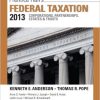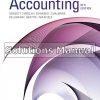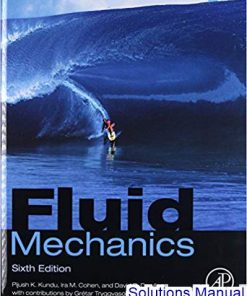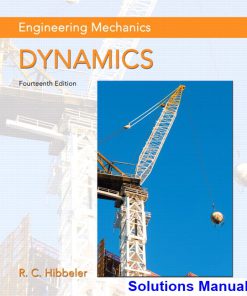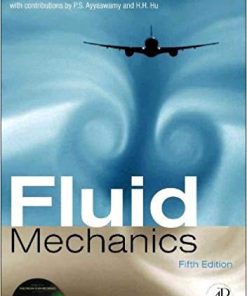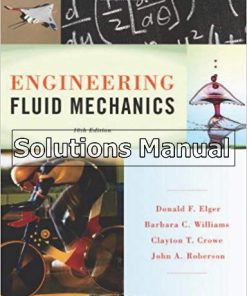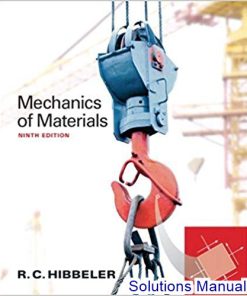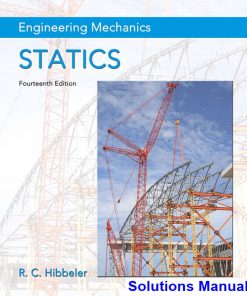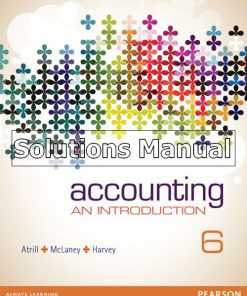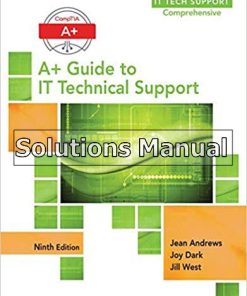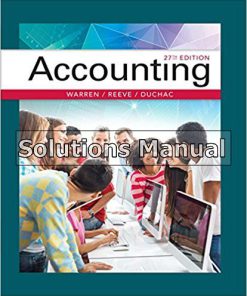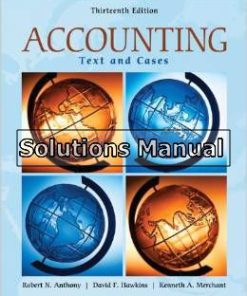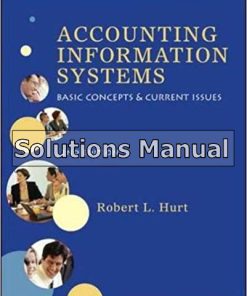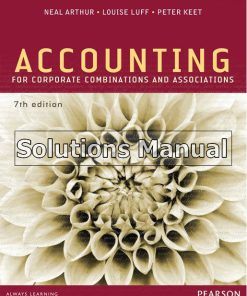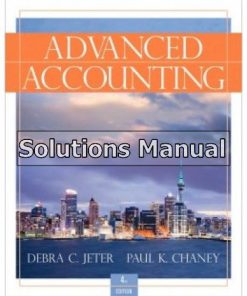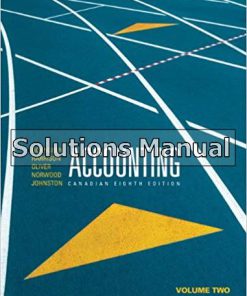Fluid Mechanics 2nd Edition Hibbeler Solutions Manual
$50.00 Original price was: $50.00.$26.50Current price is: $26.50.
Fluid Mechanics 2nd Edition Hibbeler Solutions Manual.
This is completed downloadable of Fluid Mechanics 2nd Edition Hibbeler Solutions Manual

Product Details:
- ISBN-10 : 013464929X
- ISBN-13 : 978-0134649290
- Author: R.C. Hibbeler
Fluid Mechanics provides a comprehensive guide to a full understanding of the theory and many applications of fluid mechanics. The text features many of the hallmark pedagogical aids unique to Hibbeler texts, including its student-friendly clear organization. The text supports the development of your problem-solving skills through a large variety of problems, representing a broad range of engineering disciplines that stress practical, realistic situations encountered in professional practice and varying levels of difficulty. The text offers flexibility in that basic principles are covered in chapters 1 through 6, and the remaining chapters can be covered in any sequence without the loss of continuity.
The 2nd Edition addresses comments and suggestions from colleagues, reviewers in the teaching profession, and many of the author’s students, including expanded topic coverage and new Example and Fundamental Problems intended to further your understanding of the theory and its applications.
Table of Content:
- Chapter 1 Fundamental Concepts
- Chapter Objectives
- 1.1 Introduction
- Branches of Fluid Mechanics
- Historical Development
- 1.2 Characteristics of Matter
- Solid
- Liquid
- Gas
- Continuum
- 1.3 Systems of Units
- U.S. Customary Units
- Temperature
- SI Units
- Temperature
- Conversion of Units
- Prefixes
- 1.4 Calculations
- Dimensional Homogeneity
- Rounding off Numbers
- Calculation Procedure
- 1.5 Problem Solving
- Solution
- Solution
- 1.6 Some Basic Fluid Properties
- Density
- Liquid
- Gas
- Specific Weight
- Specific Gravity
- Bulk Modulus
- Liquid
- Gas
- Ideal Gas Law
- Solution
- Solution
- 1.7 Viscosity
- Physical Cause of Viscosity
- Newton’s Law of Viscosity
- Shear Stress
- Shear Strain
- Newtonian Fluids
- Non-Newtonian Fluids
- Inviscid and Ideal Fluids
- Pressure and Temperature Effects
- Kinematic Viscosity
- 1.8 Viscosity Measurement
- Solution
- Fluid Description
- Analysis
- Solution
- Fluid Description
- Analysis
- 1.9 Vapor Pressure
- Cavitation
- 1.10 Surface Tension and Capillarity
- Surface Tension
- Liquid Drops
- Capillarity
- References
- Problems
- Sec. 1.1-1.6
- Sec. 1.7-1.8
- Sec. 1.9-1.10
- Conceptual Problems
- Chapter Review
- Chapter 2 Fluid Statics
- Chapter Objectives
- 2.1 Pressure
- Pascal’s Law
- Solution
- Fluid Description
- Analysis
- 2.2 Absolute and Gage Pressure
- Solution
- Fluid Description
- Analysis
- 2.3 Static Pressure Variation
- 2.4 Pressure Variation for Incompressible Fluids
- Pressure Head
- Solution
- Fluid Description
- Analysis
- 2.5 Pressure Variation for Compressible Fluids
- Constant Temperature
- Solution
- Fluid Description
- Analysis
- Incompressible Gas
- Compressible Gas
- 2.6 Measurement of Static Pressure
- Barometer
- Manometer
- Manometer Rule
- Differential Manometer
- Bourdon Gage
- Pressure Transducers
- Other Pressure Gages
- Solution
- Fluid Description
- Analysis
- Solution
- Fluid Description
- Analysis
- Solution
- Fluid Description
- Analysis
- 2.7 Hydrostatic Force on a Plane Surface—Formula Method
- Resultant Force
- Location of the Resultant Force
- The yP Coordinate
- The xP Coordinate
- Symmetrical Plate
- Solution
- Fluid Description
- Analysis
- Solution
- Fluid Description
- Analysis
- Solution
- Fluid Description
- Analysis
- 2.8 Hydrostatic Force on a Plane Surface—Geometrical Method
- Resultant Force
- Location
- Plate Having Constant Width
- Solution
- Fluid Description
- Analysis I
- Loading
- Resultant Forces
- Location
- Analysis II
- Loading
- Resultant Forces
- Location
- Solution
- Fluid Description
- Loading
- Resultant Force
- Location
- 2.9 Hydrostatic Force on a Plane Surface—Integration Method
- Resultant Force
- Location
- Solution
- Fluid Description
- Resultant Force
- Location
- Solution
- Fluid Description
- Resultant Force
- Location
- 2.10 Hydrostatic Force on an Inclined Plane or Curved Surface Determined by Projection
- Horizontal Component
- Vertical Component
- Liquid below Plate
- Gas
- Solution
- Fluid Description
- Horizontal Force Component
- Vertical Force Component
- Resultant Force
- Solution
- Fluid Description
- Analysis I
- Horizontal Force Component
- Vertical Force Component
- Resultant Force
- Reactions
- Analysis II
- Solution
- Fluid Description
- Analysis
- 2.11 Buoyancy
- Hydrometer
- Solution
- Fluid Description
- Analysis
- Part (a)
- Part (b)
- 2.12 Stability
- Solution
- Fluid Description
- Analysis
- 2.13 Constant Translational Acceleration of a Liquid
- Constant Horizontal Acceleration
- Vertical Element
- Horizontal Element
- Constant Vertical Acceleration
- Horizontal Element
- Vertical Element
- Solution
- Fluid Description
- Analysis
- Solution
- Fluid Description
- Analysis
- Side of Tank
- Bottom of Tank
- 2.14 Steady Rotation of a Liquid
- Vertical Element
- Ring Element
- Solution
- Fluid Description
- Analysis
- References
- Fundamental Problems
- Sec. 2.1-2.5
- Sec. 2.6
- Sec. 2.7-2.9
- Sec. 2.10
- Sec. 2.11-2.12
- Problems
- Sec. 2.1-2.5
- Sec. 2.6
- Sec. 2.7-2.9
- Sec. 2.10
- Sec. 2.11-2.12
- Sec. 2.13-2.14
- Conceptual Problems
- Chapter Review
- Chapter 3 Kinematics of Fluid Motion
- Chapter Objectives
- 3.1 Types of Fluid Flow
- Classification of Flow Based on Its Frictional Effects
- Classifications of Flow Based on Dimension
- Classification of Flow Based on Space and Time
- 3.2 Graphical Descriptions of Fluid Flow
- Streamlines
- Streamtubes
- Equation of a Streamline
- Pathlines
- Streaklines
- Optical Methods
- Computational Fluid Dynamics
- 3.3 Fluid Flow Descriptions
- Lagrangian Description—System Approach
- Eulerian Description—Control Volume Approach
- Solution
- Fluid Description
- Analysis
- Solution
- Fluid Description
- Pathline
- Streamline
- Solution
- Fluid Description
- Analysis
- 3.4 Fluid Acceleration
- Local Acceleration
- Convective Acceleration
- Three-dimensional Flow
- Solution
- Fluid Description
- Analysis
- Solution
- Flow Description
- Analysis
- Velocity
- Acceleration
- Solution
- Fluid Description
- Analysis
- 3.5 Streamline Coordinates
- Velocity
- Acceleration
- Local Change
- Convective Change
- Resultant Acceleration
- Solution
- Fluid Description
- Streamline Acceleration Component
- Normal Acceleration Component
- Acceleration
- References
- Fundamental Problems
- Sec. 3.1-3.3
- Sec. 3.4
- Sec. 3.5
- Problems
- Sec. 3.1-3.3
- Sec. 3.4
- Sec. 3.5
- Chapter Review
- Chapter 4 Conservation of Mass
- Chapter Objectives
- 4.1 Volumetric Flow, Mass Flow, and Average Velocity
- Volumetric Flow
- Average Velocity
- Mass Flow
- Solution
- Fluid Description
- Analysis
- 4.2 Finite Control Volumes
- Open Control Surfaces
- Velocity
- Steady Flow
- 4.3 The Reynolds Transport Theorem
- Fluid Property Description
- The Reynolds Transport Theorem
- Applications
- 4.4 Conservation of Mass
- Special Cases
- Solution
- Fluid Description
- Control Volume
- Continuity Equation
- Solution
- Fluid Description
- Control Volume
- Continuity Equation
- Ideal Gas Law
- Solution
- Fluid Description
- Control Volume
- Continuity Equation
- Ideal Gas Law
- Solution
- Fuel Description
- Control Volume
- Continuity Equation
- Solution
- Fluid Description
- Control Volume I
- Conservation of Mass
- Control Volume II
- Conservation of Mass
- References
- Fundamental Problems
- Sec. 4.1-4.2
- Sec. 4.4
- Problems
- Sec. 4.1-4.2
- Sec. 4.3
- Sec. 4.4
- Conceptual Problems
- Chapter Review
- Chapter 5 Work and Energy of Moving Fluids
- Chapter Objectives
- 5.1 Euler’s Equations of Motion
- s Direction
- n Direction
- Steady Horizontal Flow of an Ideal Fluid
- Solution
- Fluid Description
- Analysis
- 5.2 The Bernoulli Equation
- Limitations
- 5.3 Applications of the Bernoulli Equation
- Flow from a Large Reservoir
- Flow around a Curved Boundary
- Flow in an Open Channel
- Flow in a Closed Conduit
- Venturi meter
- Solution
- Fluid Description
- Bernoulli Equation
- Solution
- Fluid Description
- Bernoulli Equation
- Solution
- Fluid Description
- Analysis
- Continuity Equation
- Bernoulli Equation
- Solution
- Fluid Description
- Bernoulli Equation
- Continuity Equation
- Solution
- Fluid Description
- Bernoulli Equation
- 5.4 Energy and Hydraulic Grade Lines
- Solution
- Fluid Description
- Bernoulli Equation
- EGL and HGL
- Solution
- Fluid Description
- Energy Grade Line
- Hydraulic Grade Line
- Solution
- Fluid Description
- Bernoulli Equation
- EGL and HGL
- 5.5 The Energy Equation
- System Energy
- Heat Energy
- Work
- Flow Work
- Shaft Work
- Shear Work
- Energy Equation
- Incompressible Flow
- Compressible Fluid
- Power and Efficiency
- Nonuniform Velocity
- Solution
- Fluid Description
- Control Volume
- Energy Equation
- Power
- Solution
- Fluid Description
- Control Volume
- Energy Equation
- Solution
- Fluid Behavior
- Control Volume
- Continuity Equation
- Energy Equation
- Solution
- Fluid Description
- Control Volume
- Energy Equation
- Power
- EGL and HGL
- References
- Fundamental Problems
- Sec. 5.2-5.3
- Sec. 5.4
- Sec. 5.5
- Problems
- Sec. 5.1
- Sec. 5.2-5.3
- Sec. 5.4-5.5
- Conceptual Problems
- Chapter Review
- Chapter 6 Fluid Momentum
- Chapter Objectives
- 6.1 The Linear Momentum Equation
- Steady Flow
- Free-Body Diagram
- 6.2 Applications to Bodies at Rest
- Solution
- Fluid Description
- Control Volume and Free-Body Diagram
- Continuity Equation
- Bernoulli Equation
- Linear Momentum
- Solution
- Fluid Description
- Control Volume and Free-Body Diagram
- Linear Momentum
- Solution
- Fluid Description
- Control Volume and Free-Body Diagram
- Bernoulli and Continuity Equations
- Linear Momentum
- Solution
- Fluid Description
- Control Volume and Free-Body Diagram
- Linear Momentum
- 6.3 Applications to Bodies Having Constant Velocity
- Solution
- Fluid Description
- Control Volume and Free-Body Diagram
- Linear Momentum
- Solution
- Fluid Description
- Control Volume and Free-Body Diagram
- Linear Momentum
- Power
- 6.4 The Angular Momentum Equation
- Steady Flow
- Solution
- Fluid Description
- Control Volume and Free-Body Diagram
- Bernoulli Equation
- Linear and Angular Momentum
- Solution
- Fluid Description
- Control Volume and Free-Body Diagram
- Velocity
- Angular Momentum
- Solution
- Fluid Description
- Control Volume and Free-Body Diagram
- Continuity Equation
- Angular Momentum
- *6.5 Propellers and Wind Turbines
- Propeller
- Linear Momentum
- Bernoulli Equation
- Power and Efficiency
- Wind Turbine
- Power and Efficiency
- Solution
- Fluid Description
- Analysis
- 6.6 Applications for Control Volumes Having Accelerated Motion
- *6.7 Turbojets and Turbofans
- *6.8 Rockets
- Solution
- Fluid Description
- Analysis
- Solution
- Fluid Description
- Analysis
- References
- Fundamental Problems
- Sec. 6.1-6.2
- Sec. 6.3
- Problems
- Sec. 6.1-6.2
- Sec. 6.3
- Sec. 6.4
- Sec. 6.5-6.8
- Conceptual Problems
- Chapter Review
- Chapter 7 Differential Fluid Flow
- Chapter Objectives
- 7.1 Differential Analysis
- 7.2 Kinematics of Differential Fluid Elements
- Translation
- Linear Distortion
- Rotation
- Angular Distortion
- 7.3 Circulation and Vorticity
- Circulation
- Vorticity
- Irrotational Flow
- Solution
- Fluid Description
- Triangular Path
- Circular Path
- Solution
- Fluid Description
- Vorticity
- Shear-Strain Rate
- 7.4 Conservation of Mass
- Two-Dimensional Steady Flow of an Ideal Fluid
- Cylindrical Coordinates
- 7.5 Equations of Motion for a Fluid Particle
- 7.6 The Euler and Bernoulli Equations
- Two-Dimensional Steady Flow
- The Bernoulli Equation
- Solution
- Fluid Description
- Volumetric Dilatation Rate
- Rotation
- Pressure
- 7.7 Potential Flow Hydrodynamics
- 7.8 The Stream Function
- Velocity Components
- Volumetric Flow
- Solution
- Fluid Description
- Stream Functions
- Velocity
- Solution
- Fluid Description
- Velocity
- Stream Function
- Solution
- Fluid Description
- Velocity
- 7.9 The Potential Function
- Flow Net
- Solution
- Fluid Description
- Analysis
- Solution
- Fluid Description
- Analysis
- 7.10 Basic Two-Dimensional Flows
- Uniform Flow
- Line Source Flow
- Line Sink Flow
- Free-Vortex Flow
- Circulation
- Forced-Vortex Flow
- Solution
- Fluid Description
- Free Vortex
- Forced Vortex
- 7.11 Superposition of Flows
- Uniform Flow Past a Half Body
- Doublet
- Uniform Flow around a Rankine Oval
- Uniform Flow around a Cylinder
- Uniform and Free-Vortex Flow around a Cylinder
- Other Applications
- Solution
- Fluid Description
- Analysis
- Solution
- Fluid Description
- Analysis
- 7.12 The Navier-Stokes Equations
- Cylindrical Coordinates
- Solution
- Fluid Description
- Analysis
- 7.13 Computational Fluid Dynamics
- The CFD Code
- Input
- Fluid Properties
- Flow Phenomena
- Geometry
- Program
- Finite Difference Method
- Finite Element Method
- Finite Control Volume Method
- Output
- General Considerations
- References
- Problems
- Sec. 7.1-7.6
- Sec. 7.7-7.9
- Sec. 7.10-7.11
- Sec. 7.12
- Chapter Review
- Chapter 8 Dimensional Analysis and Similitude
- Chapter Objectives
- 8.1 Dimensional Analysis
- 8.2 Important Dimensionless Numbers
- Euler Number
- Reynolds Number
- Froude Number
- Weber Number
- Mach Number
- 8.3 The Buckingham Pi Theorem
- Solution
- Define the Physical Variables
- Select the Repeating Variables
- Π Term, q = D
- Dimensional Analysis
- Solution
- Define the Physical Variables
- Select the Repeating Variables
- Π1 Term q = FD
- Dimensional Analysis
- Π2 Term q = μ
- Dimensional Analysis
- Solution
- Define the Physical Variables
- Select the Repeating Variables
- Π1 Term q = FD and Dimensional Analysis
- Π2 Term q = μ and Dimensional Analysis
- Π3 Term q = g and Dimensional Analysis
- Solution
- Define the Physical Variables
- Select the Repeating Variables
- Π Terms and Dimensional Analysis
- 8.4 Some General Considerations Related to Dimensional Analysis
- 8.5 Similitude
- Geometric Similitude
- Kinematic Similitude
- Dynamic Similitude
- Steady Flow through a Pipe
- Open-Channel Flow
- Ships
- Review
- Solution
- Solution
- Solution
- Solution
- References
- Problems
- Sec. 8.1–8.4
- Sec. 8.5
- Chapter Review
- Chapter 9 Viscous Flow within Enclosed Conduits
- Chapter Objectives
- 9.1 Steady Laminar Flow between Parallel Plates
- Horizontal Flow Caused by a Constant Pressure Gradient—Both Plates Fixed
- Horizontal Flow Caused by a Constant Pressure Gradient—Top Plate Moving
- Horizontal Flow Caused Only by the Motion of the Top Plate
- Limitations
- 9.2 Navier-Stokes Solution for Steady Laminar Flow between Parallel Plates
- Solution
- Fluid Description
- Analysis
- Solution
- Fluid Description
- Analysis
- Solution
- Fluid Description
- Analysis
- 9.3 Steady Laminar Flow within a Smooth Pipe
- Horizontal Flow through a Circular Pipe
- 9.4 Navier–Stokes Solution for Steady Laminar Flow within a Smooth Pipe
- 9.5 The Reynolds Number
- Solution
- Fluid Description
- Analysis
- Solution
- Fluid Description
- Analysis
- 9.6 Fully Developed Flow from an Entrance
- Laminar Flow
- Turbulent Flow
- Solution
- Fluid Description
- Analysis
- Water
- Oil
- 9.7 Laminar and Turbulent Shear Stress within a Smooth Pipe
- Laminar Flow
- Turbulent Flow
- Turbulent Shear Stress
- 9.8 Steady Turbulent Flow within a Smooth Pipe
- Viscous Sublayer
- Transitional and Turbulent Flow Regions
- Power Law Approximation
- Solution
- Fluid Description
- Shear Stress
- Velocity
- Viscous Laminar Sublayer
- Solution
- Fluid Description
- Shear Stress
- Viscous Shear-Stress Component
- Turbulent Shear-Stress Component
- References
- Problems
- Sec. 9.1–9.2
- Sec. 9.3–9.6
- Sec. 9.7–9.8
- Chapter Review
- Chapter 10 Analysis and Design for Pipe Flow
- Chapter Objectives
- 10.1 Resistance to Flow in Rough Pipes
- Laminar Flow
- Turbulent Flow
- Moody Diagram
- Laminar Flow
- Critical Zone and Transitional Flow
- Turbulent Flow
- Empirical Solutions
- Noncircular Conduits
- Hazen–Williams Equation
- Solution
- Fluid Description
- Analysis
- Solution
- Fluid Description
- Analysis
- Solution
- Fluid Description
- Analysis
- Solution
- Fluid Description
- Analysis
- Solution
- Fluid Description
- Analysis
- 10.2 Losses Occurring from Pipe Fittings and Transitions
- Inlet and Exit Transitions
- Expansion and Contraction
- Sudden Expansion
- Sudden Contraction
- Gradual Expansion
- Pipe Connections
- Bends
- Valves
- Equivalent Length
- 10.3 Single-Pipeline Flow
- Solution
- Fluid Description
- Analysis
- Solution
- Fluid Description
- Part a)
- Analysis I
- Analysis II
- Part b)
- Analysis III
- Analysis IV
- Solution
- Fluid Description
- Analysis
- Equivalent Length of Pipe
- 10.4 Pipe Systems
- Pipes in Series
- Pipes in Parallel
- Solution
- Fluid Description
- Continuity Equation
- Energy Equation
- Moody Diagram
- Solution
- Fluid Description
- Continuity Equation
- Moody Diagram
- Energy Equation
- 10.5 Flow Measurement
- Venturi Meter
- Nozzle Meter
- Orifice Meter
- Rotometer
- Turbine Flow Meter
- Vortex Flow Meter
- Thermal Mass Flow Meter
- Positive Displacement Flow Meter
- Nutating Disk Flow Meter
- Magnetic Flow Meter
- Other Types
- References
- Fundamental Problems
- Sec. 10.1
- Sec. 10.2–10.3
- Problems
- Sec. 10.1
- Sec. 10.2–10.3
- Sec. 10.4
- Chapter Review
- Chapter 11 Viscous Flow over External Surfaces
- Chapter Objectives
- 11.1 The Concept of the Boundary Layer
- Boundary Layer Description
- Laminar Flow
- Transitional Flow
- Turbulent Flow
- Boundary Layer Thickness
- Disturbance Thickness
- Displacement Thickness
- Momentum Thickness
- Boundary Layer Classification
- 11.2 Laminar Boundary Layers
- Disturbance Thickness
- Displacement Thickness
- Momentum Thickness
- Shear Stress
- Friction Drag
- Solution
- Fluid Description
- Analysis
- Solution
- Fluid Description
- Disturbance Thickness
- Velocity
- Solution
- Fluid Description
- Displacement Thickness
- Velocity
- Solution
- Fluid Description
- Analysis
- 11.3 The Momentum Integral Equation
- Continuity Equation
- Momentum Equation
- Solution
- Fluid Description
- Boundary Layer Thickness
- Skin Friction Coefficient
- Friction Drag Coefficient
- 11.4 Turbulent Boundary Layers
- Disturbance Thickness
- Shear Stress along Plate
- Drag on Plate
- 11.5 Laminar and Turbulent Boundary Layers
- Solution
- Fluid Description
- Analysis
- Solution
- Fluid Description
- Analysis
- Solution
- Fluid Description
- Analysis
- 11.6 Drag and Lift
- Drag and Lift Components
- Solution
- Fluid Description
- Analysis
- 11.7 Pressure Gradient Effects
- Ideal Flow Around a Cylinder
- Real Flow around a Cylinder
- Vortex Shedding
- 11.8 The Drag Coefficient
- Reynolds Number
- Cylinder
- Sphere
- Froude Number
- Mach Number
- 11.9 Drag Coefficients for Bodies Having Various Shapes
- Applications
- Solution
- Fluid Description
- Analysis
- Solution
- Fluid Description
- Analysis
- Solution
- Fluid Description
- Analysis
- 11.10 Methods for Reducing Drag
- Airfoils
- Design
- Airfoil Drag Coefficients
- Road Vehicles
- 11.11 Lift and Drag on an Airfoil
- Airfoil Lift
- Circulation
- Experimental Data
- Race Cars
- Trailing Vortices and Induced Drag
- Induced Drag Coefficient
- Spinning Ball
- Solution
- Fluid Description
- Angle of Attack
- Drag
- Stall
- References
- Problems
- Sec. 11.1-11.3
- Sec. 11.4-11.5
- Sec. 11.6
- Sec. 11.7-11.9
- Sec. 11.10-11.11
- Conceptual Problems
- Chapter Review
- Chapter 12 Open-Channel Flow
- Chapter Objectives
- 12.1 Types of Flow in Open Channels
- Laminar and Turbulent Flow
- Uniform and Steady Flow
- Hydraulic Jump
- 12.2 Open-Channel Flow Classifications
- Froude Number
- 12.3 Specific Energy
- 12.4 Open-Channel Flow over a Rise or Bump
- Rise
- Bump
- Solution
- Fluid Description
- Analysis
- Solution
- Fluid Description
- Analysis
- 12.5 Open-Channel Flow under a Sluice Gate
- Solution
- Fluid Description
- Analysis
- Solution
- Fluid Description
- Analysis
- 12.6 Steady Uniform Channel Flow
- Reynolds Number
- Chézy Equation
- Manning Equation
- Best Hydraulic Cross Section
- Critical Slope
- Solution
- Fluid Description
- Analysis
- Solution
- Fluid Description
- Analysis
- Solution
- Fluid Description
- Analysis
- Solution
- Fluid Description
- Analysis
- 12.7 Gradually Varied Flow
- Rectangular Cross Section
- Surface Profiles
- Calculating the Surface Profile
- Solution
- Fluid Description
- Analysis
- Solution
- Fluid Description
- Analysis
- 12.8 The Hydraulic Jump
- Continuity Equation
- Momentum Equation
- Energy Equation
- Solution
- Fluid Description
- Analysis
- Solution
- Fluid Description
- Analysis
- 12.9 Weirs
- Sharp-Crested Weirs
- Rectangle
- Triangle
- Broad-Crested Weirs
- Solution
- Fluid Description
- Analysis
- References
- Problems
- Sec. 12.1-12.3
- Sec. 12.4
- Sec. 12.5
- Sec. 12.6
- Sec. 12.7
- Sec. 12.8
- Sec. 12.9
- Chapter Review
- Fundamental Equations of Open-Channel Flow
- Chapter 13 Compressible Flow
- Chapter Objectives
- 13.1 Thermodynamic Concepts
- Ideal Gas Law
- Internal Energy and the First Law of Thermodynamics
- Specific Heat
- Constant-Volume Process
- Constant-Pressure Process
- Entropy and the Second Law of Thermodynamics
- Isentropic Process
- Solution
- Fluid Description
- Change in Enthalpy
- Change in Internal Energy
- Change in Entropy
- Solution
- Fluid Description
- Temperature
- Density
- 13.2 Wave Propagation through a Compressible Fluid
- Continuity Equation
- Linear Momentum Equation
- 13.3 Types of Compressible Flow
- Subsonic Flow, < 1
- Sonic and Supersonic Flow, M ≥ 1
- Mach Cone
- Solution
- Fluid Description
- Analysis
- 13.4 Stagnation Properties
- Stagnation Temperature
- Stagnation Pressure
- Stagnation Density
- Solution
- Fluid Description
- Analysis
- Solution
- Fluid Description
- Stagnation Temperature
- Stagnation Pressure
- Solution
- Fluid Description
- Analysis
- 13.5 Isentropic Flow through a Variable Area
- Continuity Equation
- Linear Momentum Equation
- Subsonic Flow
- Supersonic Flow
- Laval Nozzle
- Area Ratios
- Solution
- Fluid Description
- Throat Area
- Properties at Section 2
- 13.6 Isentropic Flow through Converging and Diverging Nozzles
- Converging Nozzle
- Converging-Diverging Nozzle
- Solution
- Fluid Description
- Analysis
- Solution
- Fluid Description
- Analysis
- Solution
- Fluid Description
- Analysis
- Solution I
- Fluid Description
- Analysis
- Solution II
- 13.7 The Effect of Friction on Compressible Flow
- Continuity Equation
- Linear Momentum Equation
- Ideal Gas Law
- Energy Equation
- Pipe Length versus Mach Number
- Temperature
- Velocity
- Density
- Pressure
- The Fanno Line
- Solution
- Fluid Description
- Maximum Pipe Length
- Flow Properties at L = 0.8 m
- Solution
- Fluid Description
- L = 1 m
- L = 2 m
- Solution
- Fluid Description
- Mass Flow
- Stagnation Temperature and Pressure
- Friction Force
- 13.8 The Effect of Heat Transfer on Compressible Flow
- Continuity Equation
- Linear Momentum Equation
- Ideal Gas Law
- Energy Equation
- Velocity
- Density
- Pressure
- Temperature
- Stagnation Temperature and Pressure
- Rayleigh Line
- Solution
- Fluid Description
- Air Properties at Critical Location
- Air Properties at Section 2
- 13.9 Normal Shock Waves
- Continuity Equation
- Linear Momentum Equation
- Ideal Gas Law
- Energy Equation
- Relationship between Mach Numbers
- 13.10 Shock Waves in Nozzles
- Solution
- Fluid Description
- Analysis
- Solution
- Fluid Description
- Analysis
- Solution
- Fluid Description
- Analysis
- 13.11 Oblique Shock Waves
- Continuity Equation
- Momentum Equation
- Energy Equation
- Solution
- Fluid Description
- Analysis
- 13.12 Compression and Expansion Waves
- Solution
- Fluid Description
- Analysis
- 13.13 Compressible Flow Measurement
- Pitot Tube and Piezometer
- Subsonic Flow
- Supersonic Flow
- Venturi Meter
- References
- Problems
- Sec. 13.1
- Sec. 13.2-13.4
- Sec. 13.5-13.6
- Sec. 13.7-13.8
- Sec. 13.9-13.10
- Sec. 13.11-13.12
- Chapter Review
- Fundamental Equations of Compressible Flow
- Chapter 14 Turbomachines
- Chapter Objectives
- 14.1 Types of Turbomachines
- 14.2 Axial-Flow Pumps
- Continuity
- Angular Momentum
- Power
- Flow Kinematics
- Solution
- Fluid Description
- Kinematics
- Solution I
- Solution II
- Solution III
- Solution
- Fluid Description
- Kinematics
- Torque and Power
- 14.3 Radial-Flow Pumps
- Kinematics
- Continuity
- Angular Momentum
- Power
- Flow within the Casing
- 14.4 Ideal Performance for Pumps
- Head Loss and Efficiency
- Head-Discharge Curve—Radial-Flow Pump
- Solution
- Fluid Description
- Pump Head
- Hydraulic Efficiency
- Solution
- Fluid Description
- Kinematics
- Flow
- Hydraulic Efficiency
- SOLUTION I
- Fluid Description
- Kinematics
- Ideal Power
- SOLUTION II
- 14.5 Turbines
- Impulse Turbines
- Torque
- Power
- Solution
- Fluid Description
- Kinematics
- Power
- Reaction Turbines
- Kinematics
- Torque
- Power
- Head and Efficiency
- Solution
- Fluid Description
- Kinematics
- Power
- Head Loss
- 14.6 Pump Performance
- Manufacturer’s Pump Performance Curves
- 14.7 Cavitation and the Net Positive Suction Head
- Solution
- Fluid Description
- Inlet Pressure
- 14.8 Pump Selection Related to the Flow System
- Solution
- Fluid Description
- System Equation
- 14.9 Turbomachine Similitude
- Pump Scaling Laws
- Specific Speed
- Solution
- Solution
- Solution
- References
- Problems
- Sec. 14.1-14.2
- Sec. 14.3-14.4
- Sec. 14.5
- Sec. 14.6-14.8
- Sec. 14.9
- Chapter Review
- Appendix A Physical Properties of Fluids
- Appendix B Compressible Properties of a Gas (K = 1.4)
- Fundamental Solutions
- Chapter 2
- Chapter 3
- Chapter 4
- Chapter 5
- Chapter 6
- Chapter 10
- Answers to Selected Problems
- Chapter 1
- Chapter 2
- Chapter 3
- Chapter 4
- Chapter 5
- Chapter 6
- Chapter 7
- Chapter 8
- Chapter 9
- Chapter 10
- Chapter 11
- Chapter 12
- Chapter 13
- Chapter 14
- Index
- A
- B
- C
- D
- E
- F
- G
- H
- I
- K
- L
- M
- N
- O
- P
- Q
- R
- S
- T
- U
- V
- W
- Z
- Fundamental Equations of Fluid Mechanics
People Also Search:
fluid mechanics
fluid mechanics hibbeler
fluid mechanics 2nd edition hibbeler
fluid mechanics 2nd edition
fluid mechanics 2nd edition solution manual download pdf
fluid mechanics 2nd edition download scribd
Instant download after Payment is complete
You may also like…
Solutions Manual
Solutions Manual
Solutions Manual
Engineering Fluid Mechanics 10th Edition Elger Solutions Manual
Solutions Manual
Mechanics Of Materials 9th Edition Hibbeler Solutions Manual
Related products
Solutions Manual
Accounting An Introduction 6th Edition Atrill Solutions Manual
Solutions Manual
A+ Guide to IT Technical Support Hardware and Software 9th Edition Andrews Solutions Manual
Solutions Manual
Solutions Manual
Accounting Texts and Cases 13th Edition Anthony Solutions Manual
Solutions Manual
Accounting Information Systems 2nd Edition Hurt Solutions Manual
Solutions Manual
Solutions Manual
Solutions Manual
Accounting Volume 2 Canadian 8th Edition Horngren Solutions Manual


